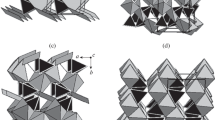Abstract
Long-range ordering of tetrahedral cations in micas is favored by phengitic compositions, by the 3T stacking sequence of layers, and by tetrahedral Si:Al ratios near 1:1. Phengites of the 1M, 2M1, and 2M2 polytypes are said to show partial ordering of tetrahedral cations, although the amounts of tetrahedral substitutions are small and the accuracies of determination are not as large as desired. The 3T structures of muscovite, paragonite, lepidolite, and protolithionite show tetrahedral ordering, as do the 2M1 brittle micas margarite and an intermediate between margarite and bityite. Muscovite-3T and margarite-2M1 are also slightly phengitic relative to their ideal compositions. Examples of octahedral cation ordering in micas are more abundant and are to be expected when cations of different size and charge are present. Octahedron M(1) with its OH,F groups in the trans orientation tends to be larger than the mean of the two cis octahedra as a result of the ordering of cations and vacancies. In some samples ordering has reduced the true symmetry to a subgroup of that of the ideal space group. If ordering in subgroup symmetry results in ordered patterns of different geometries but similar energies in very small domains, the average over all unit cells may simulate long-range disorder.
Резюме
Длиннопробежному упорядочению тетраэдрических катионов в слюдах благоприятствуют фенгитические составы, порядок 3T расположения слоев и тетраэдрически отношения Si:Al близкие 1:1. Считается, что фенгиты политипов 1M, 2M1, и 2M2 показывают частично упорядочение тетраэдрических катионов, хотя количества тетраэдрических замещений неболшие и точности их определения не так высоки, как желаемые. 3T структуры мусковита, парагонита, лепидолита, про-толитионита показывают тетраэдрическое упорядочение также, как 2M1 хрупкий Маргарит и промежуточные слюды между маргаритом и битиитом. Мусковит 3T и Маргарит 2M1 являются также немного фенгитическими по отношению к их идеальным составам. Примеры упорядочения октаэ-дрических катионов в слюде более распространены и могут выступать в присутствии катионов различных размеров и зарядов. Размер октаэдрона M(1) со своими OH,F группами с транс ориентацией стремится быть больше, чем средняя размеров двух октаэдров в ориентации цис, как результат упорядочения катионов и свободных мест. В некоторых образцах упорядочение уменьшало истинную симметрию до подгруппы идеальной пространственной группы. Если результатом упорядочения в симметрии подгруппы являются упорядоченные образцы различных геометрий, но с похожими энергиями в очень маленьких областях, суммарная средняя всех элементарных ячеек может симулировать длиннопробежное неупорядочение. [E.G.]
Resümee
Eine weitreichende Ordnung der tetraedrischen Kationen in Glimmern wird durch eine phengitische Zusammensetzung, durch die 3T Stapelungsfolge der Schichten und durch tetraedrische Si:Al-Verhältnisse nahe 1:1 begünstigt. Es heißt, daß Phengite der Polytype 1M, 2M1, und 2M2 eine teilweise Ordnung der Tetraederkationen aufweisen, obwohl das Ausmaß der tetraedrischen Substitution klein ist, und die Bestimmungsgenauigkeiten nicht zu groß sind, wie man es sich wünschen würde. Die 3T Strukturen von Muskovit, Paragonit, Lepidolith und Protolithionit zeigen tetraedrische Ordnung und ebenso die 2M1 Sprödglimmer Margarit und ein Zwischenglied zwischen Margarit und Bityit. Muskovit-3T und Margarit-2M1 sind ebenso leicht phengitisch, vergleichen mit ihren idealen Zusammensetzungen. Beispiele für oktaedrische Kationenordnung in Glimmern sind häufiger. Sie sind zu erwarten, wenn Kationen unterschiedlicher Größe und Ladung vorhanden sind. Das Oktaeder M(1) mit seinen OH,F Gruppen in der trans-Stellung tendiert dazu, größer zu sein als der Durchschnitt der beiden cis-Oktaeder, infolge der Ordnung von Kationen und Leerstellen. In einigen Proben hat die Ordnung die wahre Symmetrie auf eine Untergruppe der idealen Raumgruppe reduziert. Wenn die Einordnung in eine Untergruppensymmetrie zu einem geordneten Muster von verschiedenen Geometrien aber ähnlichen Energien in sehr kleinen Domänen führt, dann kann der Durchschnitt aus allen Einheitszellen eine weitreichende Unordnung vortäuschen. [U.W.]
Résumé
L’ordonnement à longue échéance de cations tétraèdraux dans des micas est favorisé par des compositions phengitiques, par des séquences d’empilement de couches 3T et par des proportions té-traèdrales Si:Al près d’ 1:1. On dit que des phengites de polytypes 1M, 2M1, et 2M2 montrent un ordonneront partiel de cations tétraèdraux, quoique les quantités de substitutions tétraèdrales sont petites et la precision de détermination pas aussi grande qu’on la désirerait. Les structures 3T de muscovite, de paragonite, de lepidolite, et de protolithionite montrent un ordonnement tétraèdral, comme le font également les micas cassants margarite et un intermédiaire entre la margarite et la bityite. La muscovite-3T et la margarite-2M1 sont aussi légèrement phengitiques par rapport à leurs compositions idéales. Des exemples d’ordonnement de cations octaèdraux dans des micas sont plus abondants comme l’on s’y attendrait lorsque des cations de taille et de charge différentes sont présents. L’octaèdre M(1) avec ses groupes OH,F dans l’orientation trans tend à être plus grand que la moyenne des deux octaèdres cis, un résultat de l’ordonnement des cations et des espaces vides. Dans quelques échantillons, l’ordonnement a réduit la symmetrie réelle à un sous-groupe de celle du groupe d’espace idéal. Si l’ordonnement dans la symmetrie de sous-groupe résulte en des modèles de géométrie différente mais d’énergies semblables dans de très petits domaines, la moyenne totale de mailles peut simuler le désordre à longue échéance. [D.J.]
Similar content being viewed by others
References
Bailey, S. W. (1975) Cation ordering and pseudosymmetry in later silicates: Amer. Mineral. 60, 175–187.
Bailey, S. W. (1980) Structures of layer silicates: in Crystal Structures of Clay Minerals and Their X-ray Identification, G. W. Brindley and G. Brown, eds., Mineralogical Soc., London, 1–124.
Baur, W. H. (1970) Bond length variations and distorted coordination polyhedra in inorganic crystals: Trans. Amer. Cryst. Assoc. 6, 129–155.
Brown, B. E. (1978) The crystal structure of a 3T lepidolite: Amer. Mineral. 63, 332–336.
Cruickshank, D. W. J. (1949) The accuracy of electron-density maps in X-ray analysis with special reference to dibenzyl: Acta Cryst. 2, 65–82.
Gatineau, L. (1964) Structure réele de la muscovite. Répartition des substitutions isomorphes: Bull. Soc. Fr. Minér. Cristallogr. 87, 321–355.
Gatineau, L. and Méring, J. (1966) Relations ordre-désordre dans les substitutions isomorphiques des micas: Bull. Groupe Fr. Argiles 18, 67–74.
Guggenheim, S. (1981) Cation ordering in lepidolite: Amer. Mineral. 66, 1221–1232.
Guggenheim, S. and Bailey, S. W. (1975) Refinement of the margarite structure in subgroup symmetry: Amer. Mineral. 60, 1023–1029.
Guggenheim, S. and Bailey, S. W. (1977) The refinement of zinnwaldite-1M in subgroup symmetry: Amer. Mineral. 62, 1158–1167.
Guggenheim, S. and Bailey, S. W. (1978) Refinement of the margarite structure in subgroup symmetry: correction, further refinement, and comments: Amer. Mineral. 63, 186–187.
Güven, N. (1971a) The crystal structure of 2M1 phengite and 2M1 muscovite: Z. Kristallogr. 134, 196–212.
Güven, N. (1971b) Structural factors controlling stacking sequences in dioctahedral micas: Clays & Clay Minerals 19, 159–165.
Güven, N. and Burnham, C. W. (1967) The crystal structure of 3T muscovite: Z. Kristallogr. 125, 1–6.
Hazen, R. M. and Burnham, C. W. (1973) The crystal structure of one-layer phlogopite and annite. Amer. Mineral. 58, 889–900.
Kodama, H., Alcover, J. F., Gatineau, L., and Méring, J. (1971) Diffusions anormales (rayons X et éléctrons) dans les phyllosilicates 2-1: in Structure et Propriétés de Surface des Minéraux Argileux Symposium, Louvain, 1971, 15–17.
Levillain, C., Maurel, P., and Menil, F. (1981) Mössbauer studies of synthetic and natural micas on the polylithionitesiderophyllite join: Phys. Chem. Minerals 7, 71–76.
Levinson, A. A. (1953) Studies in the mica group: Relationship between polymorphism and composition in the muscovite-lepidolite series: Amer. Mineral. 38, 88–107.
Lin, Cheng-yi and Bailey, S. W. (1984) The crystal structure of paragonite-2M1: Amer. Mineral. 69, (in press).
Lin, J.-C. and Guggenheim, S. (1983) The crystal structure of a Li,Be-rich brittle mica: a dioctahedral-trioctahedral intermediate: Amer. Mineral. 68, 130–142.
Ohta, T., Takeda, H., and Takéuchi, Y. (1982) Mica polytypism: similarities in the crystal structures of coexisting 1M and 2M1 oxybiotite: Amer. Mineral. 67, 298–310.
Pavlishin, V. I., Semenova, T. F., and Rozhdestvenskaya, I. V. (1981) Protolithionite-3T: structure, typomorphism, and practical significance: Mineralog. Zhurnal 3, 47–60 (in Russian).
Sanz, J. and Stone, W. E. E. (1979) NMR study of micas, II. Distribution of Fe2+, F−, and OH− in the octahedral sheet of phlogopites: Amer. Mineral. 64, 119–126.
Sartori, F., (1976) The crystal structure of a 1M lepidolite: Tschermaks Mineral. Petrogr. Mitt. 23, 65–75.
Sartori, F., Franzini, M., and Merlino, S. (1973) Crystal structure of a 2M2 lepidolite: Acta Crystallogr. B29, 573–578.
Sidorenko, O. V., Zvyagin, B. B., and Soboleva, S. V. (1975) Crystal structure refinement for 1M dioctahedral mica: Kristallografiya 20, 332–335 (Engl. transi.).
Sidorenko, O. V., Zvyagin, B. B., and Soboleva, S. V. (1977) The crystal structure of 3T paragonite: Kristallografiya 22, 557–560 (Engl. transi.).
Smith, J. V. and Yoder, H. S. (1956) Experimental and theoretical studies of the mica polymorphs: Mineralog. Mag. 31, 209–235.
Soboleva, S. V. and Mineeva, R. M. (1981) Stabilité de différents polytypes de micas dioctaédriques en fonction des potentiels partiels sur les atomes: Bull. Mineral. 104, 223–228.
Swanson, T. H. and Bailey, S. W. (1981) Redetermination of the lepidolite-2M1 structure: Clays & Clay Minerals 29, 81–90.
Takeda, H. and Burnham, C. W. (1969) Fluor-polylithionite: a lithium mica with nearly hexagonal (Si2O5)2− ring: Mineral. Jour. 6, 102–109.
Takeda, H., Haga, N., and Sadanaga, R. (1971) Structural investigation of polymorphic transition between 2M2-, 1M- lepidolite and 2M1 muscovite: Mineral. Jour. 6, 203–215.
Takéuchi, Y. and Sadanaga, R. (1966) Structural studies of brittle micas. (I) The structure of xanthophyllite refined: Mineral. Jour. 4, 424–437.
Toraya, H. (1981) Distortions of octahedra and octahedral sheets in 1M micas and the relation to their stability: Z. Kristallogr. 157, 173–190.
Toraya, H., Iwai, S., Marumo, F., Daimon, M., and Kondo, R. (1976) The crystal structure of tetrasilicic potassium fluor mica, KMg2.5Si4O10F2: Z. Kristallogr. 144, 42–52.
Toraya, H., Iwai, S., and Marumo, F. (1977) The crystal structure of taeniolite, KLiMg2Si4O10F2: Z. Kristallogr. 146, 73–83.
Toraya, H., Iwai, S., and Marumo, F. (1978) The crystal structure of germanate micas, KMg2.5Ge4O10F2 and KLiMg2Ge4O10F2: Z. Kristallogr. 148, 65–81.
Veblen, D. R. (1983) Exsolution and crystal chemistry of the sodium mica wonesite: Amer. Mineral. 68, 554–565.
Velde, B. (1980) Cell dimensions, polymorph type, and infrared spectra of synthetic white micas: the importance of ordering: Amer. Mineral. 65, 1277–1282.
Zhoukhlistov, A. P., Zvyagin, B. B., Soboleva, S. V., and Fedotov, A. F. (1973) The crystal structure of the dioctahedral mica 2M1 determined by high voltage electron diffraction: Clays & Clay Minerals 21, 465–470.
Author information
Authors and Affiliations
Rights and permissions
About this article
Cite this article
Bailey, S.W. Review of Cation Ordering in Micas. Clays Clay Miner. 32, 81–92 (1984). https://doi.org/10.1346/CCMN.1984.0320201
Received:
Accepted:
Published:
Issue Date:
DOI: https://doi.org/10.1346/CCMN.1984.0320201




